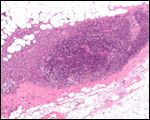Phase III Randomized Breast Cancer Lymph Node Study Likely to be Practice-Changing
Axillary lymph node dissections (ALND) remain the standard of care for breast cancer patients that have sentinel lymph node metastases. However, the procedure carries the risk of serious complications such as infection, lymphedema, and seroma.
Axillary lymph node dissections (ALND) remain the standard of care for breast cancer patients that have sentinel lymph node metastases. This is based on a meta-analysis of breast cancer patients showing that locally controlling breast cancer via lymph node dissection improved disease patient survival. However, the procedure carries the risk of serious complications such as infection, lymphedema, and seroma. Sentinel lymph node dissection (SLND) was developed to decrease these risks while still accurately staging lymph nodes.

Micrograph showing a lymph node invaded by ductal breast carcinoma and with extranodal extension of tumor. Courtesy of Nephron, Wikimedia Commons
Whether ALND affects overall survival in breast cancer with sentinel lymph node metastasis or whether SLND alone is sufficient is now addressed in a randomized, multi-center, phase III non-inferiority trial published in a February edition of the Journal of the American Medical Association (doi: 10.1001/jama.2011.90). The study of state I or IIA breast cancer patients began in 1999, enrolling 891 patients who were randomized 1:1 to receive either SLND followed by ALND or SLND alone. Both groups had a lumpectomy (the removal of the tumor) and adjuvant systemic treatment. The study was funded and designed by the American College of Surgeons Oncology Group in collaboration with the National Institute on Cancer.
The median number of lymph nodes removed in the ALND group was 17 compared with 2 in the SLND group. The adjuvant systemic therapies received by both groups were comparable: 96% and 97% of the ALND and SLND patients, respectively, received similar adjuvant therapies. The majority of patients received whole-breast radiation therapy. Age, stage of cancer, and tumor size did not vary significantly between the two groups.
ALND Does Not Increase Survival
The use of SLND compared to ALND was not statistically inferior in terms of overall survival (P = .008). The 5-year overall survival rates were 92.5% and 91.8% in the SLND-alone compared to the ALND group. Likewise, disease-free survival did not vary between the groups. Morbidity, however, was much higher in the ALND group: the rate of wound infections, axillary seromas, and lymphedema were all significantly more frequent.
The authors attributed the overall high frequency of good outcomes on improved breast cancer management including better imaging, more detailed pathological evaluation, and improved surgical and radiation approaches.
Study Implications
The trial results suggest that women may be exposed to morbidity due to ALND with no meaningful improvement in overall survival, including for women classified as high-risk (estrogen and progesterone receptor negative patients). The limitations of the study, as cited by the authors, is a failure to achieve a target accrual of 1900 patients as well as a potential randomization imbalance that favored the SLND-only cohort. Additionally, the patient follow-up was approximately 6 years and a longer-term follow-up would be beneficial, as early-stage breast cancer can reoccur at 10 to 15 years after diagnosis.
According to this randomized phase III trial, knowing the number of nodes containing metastases by ALND does not change recommendations for systematic therapy decisions and is obtained at the cost of higher morbidity from surgery, including pain, limited range of motion, and lymphedema.
As Gary Lyman, MD, professor of medicine and Chair of the ASCO Sentinel Lymph Node Biopsy Guideline Panel pointed out in an ASCO editorial in response to the publication, the data will likely change physician practice for early stage disease. However, he cautioned that the study results do not apply to early-stage patients with high risk for reoccurrence including those with three or more positive sentinel lymph nodes, larger tumors, or those who received preoperative chemotherapy.
Gedatolisib Combo With/Without Palbociclib May Be New SOC in PIK3CA Wild-Type Breast Cancer
December 21st 2025“VIKTORIA-1 is the first study to demonstrate a statistically significant and clinically meaningful improvement in PFS with PAM inhibition in patients with PIK3CA wild-type disease, all of whom received prior CDK4/6 inhibition,” said Barbara Pistilli, MD.